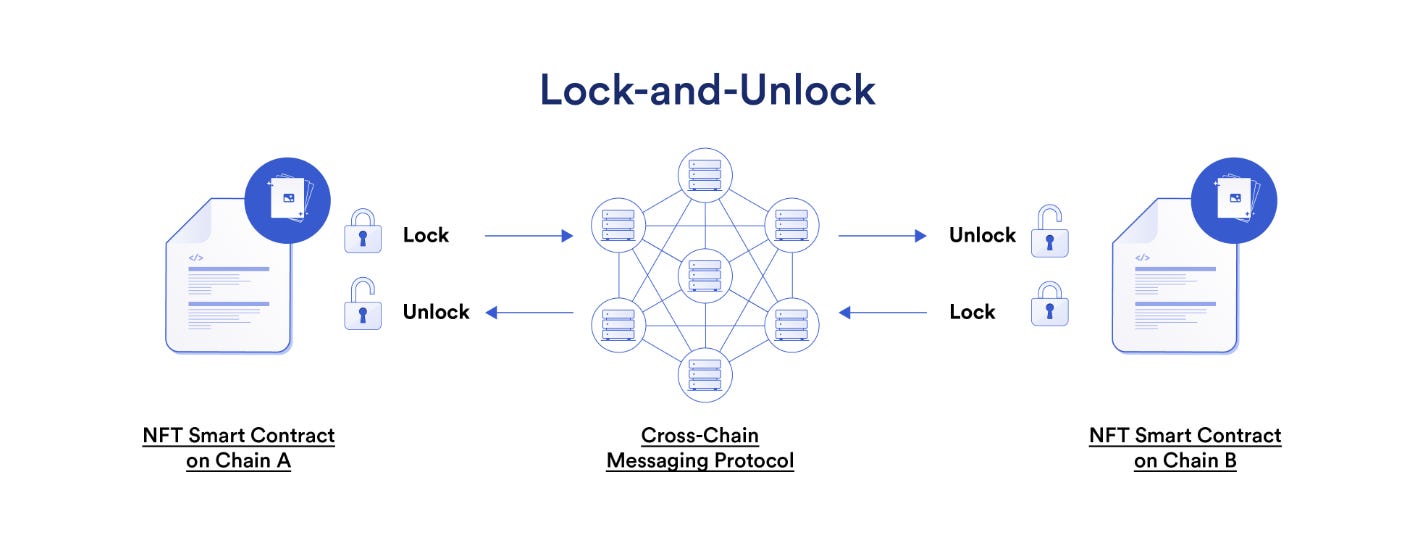Dear Bankless Nation,
New L1s and new L2s continue to proliferate.
That said, the Ethereum Virtual Machine (EVM) compatibility paradigm and UX strides will make moving fungible tokens across chains increasingly streamlined.
But what about for non-fungible tokens, what options exist for NFTs to move from one chain to another?
Let’s answer that question by going over the basics of cross-chain NFT approaches for today’s post!
-WMP
An Intro to Cross-Chain NFTs
There’s no one “right way” per se when it comes to moving an NFT from one chain to another, as we’ve seen a range of different approaches used for this to date, all with their own tradeoffs.
For me, the first approach that comes to mind here is what I’d call equivalent bridging, like as in moving an NFT from Ethereum to a different chain that’s effectively equivalent to Ethereum at the protocol level, e.g. the Optimism layer-two (L2) scaling solution.
Indeed, after its Bedrock upgrade earlier this year Optimism boasts near-perfect Ethereum equivalence, so if you bridge an NFT from Ethereum to Optimism it’s sort of like bridging an NFT from Ethereum to Ethereum.
The Quix marketplace (which became community-run earlier this year) has offered such an NFT bridge previously, but now it might just be a theoretical example — I wasn’t able to get it to work when I last tried. You get the idea though!
Admittedly, we haven’t seen much equivalent bridging in the NFT ecosystem yet. What has been much more common, though, is collection-wide migrations using the cruder but also fairly practical burn-and-mint method.
By burn-and-mint, I mean a process in which a collection holder can burn their NFT on one chain and then receive an official collection-approved re-mint of it on a new chain. This is typically just cast as a “bridging” experience. An example here would be y00ts, which has used this method not once but twice in migrating from Solana to Polygon and then from Polygon to Ethereum.

Another approach that’s growing in popularity lately is the lock-and-mint method popularized by the omnichain NFTs of interoperability protocol LayerZero. You might have seen this in action before via the Lil Pudgys Bridge, which supports transfers to Arbitrum, BNB Chain, and Polygon.

The way this architecture works is that LayerZero offers a smart contract system that lets you turn a regular NFT into an ONFT, after which you can deploy that ONFT on LayerZero-supported chains.
To then move cross-chain, the ONFT becomes locked on the source chain and minted on the destination chain, and to move back, the ONFT becomes locked on the new source chain and the original NFT becomes unlocked on the original source chain.

Yet LayerZero is just one interoperability protocol. A project notably building support for LayerZero and additional messaging protocols simultaneously is Holograph.

Zooming in, Holograph has created a new primitive known as Holographic Assets, an instance of which are hNFTs that let you mint NFTs that “maintain the same contract address and token ID on all EVM environments, enabling them to move between blockchains with perfect provenance.”
For anyone who remembers my recent RWA x NFTs post, note that Holograph is working toward hNFTs as a standard for tokenizing real world assets and “decoupling the asset layer from the blockchain layer.”
On the point of additional messaging protocols, though, another one that shows great promise is Chainlink’s new Cross-Chain Interoperability Protocol (CCIP). Of course, the CCIP system is aimed at doing much more than just supporting cross-chain NFTs, but here it can excel across a range of use cases like cross-chain games, cross-chain NFTfi, and universal NFTs. Affine, a DeFi project, is specifically tapping this system to power its Affine Pass NFTs, for example.

So while some efforts like CCIP want to offer a way for everything to be made cross-chain compatible, on the flip side some projects are building their own bespoke cross-chain solutions for their own singular needs.
Toward this end, the onchain RPG Pirate Nation comes to mind, as it’s developed a custom Mirroring system that facilitates a Trade on L1 / Play on L2 method: the original Founder’s Pirates NFTs stay on Ethereum while their mirrors on Arbitrum Nova facilitate gas-free gameplay.

This concept brings us full circle to having NFTs on one chain but not having to move them cross-chain at all in order to “use” them on another chain. This type of utility is made possible by services like UMA’s Optimistic Oracle, which can consider NFTs on one chain while enforcing actions on another.
To close and zoom back out, then, it’s clear that where NFTs are concerned the lines between blockchains are increasingly blurring as cross-chain efforts of all stripes are starting to gain ground. In the near term, there will be various challenges and obstacles to face in this arena, but there will also be new possibilities, new innovations, and new experiences. Keep your eyes peeled here accordingly!
